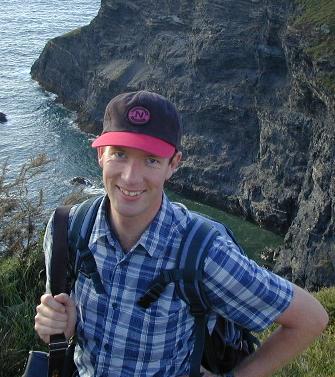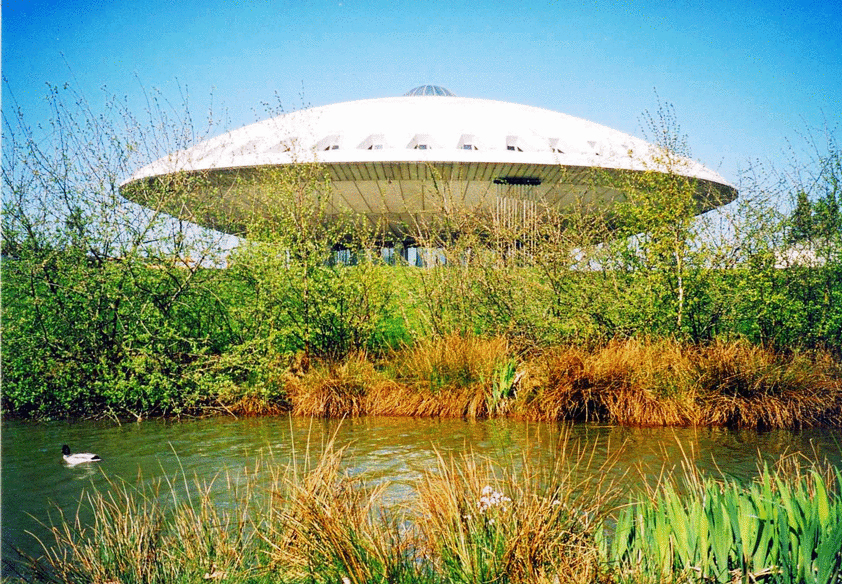by Hinke Osinga, University of Bristol, UK
 |
Gerton Lunter studied
both Mathematics and Physics at the University of Groningen in the
Netherlands. Already during his school days he was also very much
intrigued by computer science and he loved to program. He got an MSc
degree in Mathematics in 1994 and continued studying for a PhD in
Dynamical Systems under the supervision of Henk Broer and Gert
Vegter. "I was always fascinated by the pictures and, in
particular, fractals in dynamical systems; isn't it amazing how very
complex fractal structures emerge from really simple computer
programs?" The particular choice of specializing in dynamical
systems was also guided by the fact that dynamical systems is a very
broad subject that utilizes many aspects of mathematics and that
computer programming plays an important role in the analysis of
dynamic behavior. |
| Gerton Lunter in
Cornwall, summer 2003 |
In December 1999 Gerton obtained a PhD with his thesis Bifurcations
in Hamiltonian Systems; Computing Singularities by Gröbner
Bases. Even though his thesis contains lots of pretty pictures
and complex fractal structures, and despite the fact that the use of
Gröbner bases lead to a natural algorithm for deriving normal
forms that was "a lot of fun to program", his pleasure in pure
fundamental research had dwindled and Gerton opted for a career in
industry. "I had started my PhD research believing that dynamical
systems was a field with exciting applications that are physically
relevant, but during my PhD I sometimes felt that my research was
leading nowhere. Moreover, nobody seemed to be interested in what I
was doing. I was in need of appreciation for my skills and decided to
search for work that was oriented towards specific goals and with very
practical applications. I wanted to do something that was of interest
to people."
Getting the job
As a child, Gerton had visited the
Evoluon in Eindhoven for the special exhibit on science and technology; this exhibition opened in
1966 to celebrate the 75th birthday of the Philips company and ran
until 1989. It was here that he learned about
Philips
Research. Officially called Philips Natuurkundig Laboratorium,
this is the biggest company research laboratory in Europe, with a
total of (then) 1500 people. It is here where they invented cassettes
and CDs. It is also here where Balthasar van der Pol (1889-1959)
invented the famous Van der Pol equations. Many years later, it was
obvious to Gerton to send Philips an open application.
After four months he received an invitation for an interview. The
interview did not take long. "They let me talk with five people. The
funny thing was that they hardly asked me anything! They just told me
what they were working on. I decided to simply listen and ask a
question every now and then to show that I was interested. At the end
of the interview they gave me the job."
| Gerton
goes on explaining that, interestingly, at Philips Research,
you effectively sign your contract without knowing what exactly you
will be working on. Namely, once Philips Research offers you a
position, you still have to go through another round of interviews. In
this second round you are told about specific project groups in
detail. "I talked to people from audio signal processing, video signal
processing, chip design, and modeling of transistor
characteristics. At the end of this day, I could choose what
interested me most and I decided to join the video signal processing
group." |
 |
| The Evoluon in
Eindhoven |
Working for Philips
Gerton's project had to do with so-called motion estimation.
Ordinary televisions project 50 images per second on the
screen. However, a 100Hz TV also receives only 50 images and the
information must be doubled to 100 images by interpolation. A simple
solution would be to simply show each image twice before moving on to
the next. However, watching a person walk across the screen would then
result in what is called judder. Namely, your eyes
(unnoticably) adapt to the apparent motion in the images provided and
start anticipating the position of the moving person on the subsequent
images. This results in the motion being perceived as
jerky, i.e. judder.
More advanced techniques use the information obtained from two
subsequent images and interpolate between two positions. The best
solution currently available uses linear interpolation between two
images, but based on a low-resolution motion vector field on 8x8 pixel
blocks. Hence, the vector field does not quite fit around the object,
and especially with fast-moving objects, this results in a blurry
region around the edges, which is called the halo effect.
Can one do better, even with the restriction that, of course, this
interpolation must be done in real time? There are also economic and
manufacturing restrictions: the production costs of the chip must not
exceed $10.
This is exactly what Gerton found appealing about the problem.
During his mathematics studies he obtained a lot of skills and it was
fun to apply these tools to a practical problem while dealing with all
these extra non-mathematical restrictions. The intruiging part is that
there is typically already a solution at hand. "These engineers have a
really good intuition. They immediately see what the potential
limitations are, both in terms of the technical and economic
restrictions, and are very quick in proposing a feasible algorithm.
However, this may not be a very good solution and certainly not
the optimal one. A thorough more fundamental analysis, or even an
investigation of how the problem behaves, is not their approach to
such a problem. That was my work and I used it to try make the
solution better, or propose a radical change to the algorithm."
Contrasts and similarities between University and Philips
Gerton has a tremendous respect and admiration for the organization
within Philips Research. "Their way of working is totally different
from what I was used to at the University of Groningen." First of all,
the projects are a lot shorter, only six to twelve months, with long
projects lasting no more than two years. "For each project, even those
involving fundamental research, there are very clear agreements about
the objectives, the time-frame, and assessment of intermediate
goals. It is also clear who is responsible for the project and who
assesses it." PhD research at a university can also be on a specific
project with pre-defined objectives. However, according to Gerton, if
the research does not seem to go anywhere, then this is the problem of
the PhD student who should struggle on to get some results. If a
project is not going well at Philips Research, then the group leader
(who oversees about 45 people) can decide to put you to work somewhere
else. "This man has an incredible skill to judge whether you are
suitable for the project or not, and whether you would enjoy something
else better. Obviously, this makes both you and Philips happy."
Gerton found the work and research at Philips in many ways very
similar to PhD research at a university. "We were certainly expected
to publish in international journals. There were group meetings and
seminars, we had a very good library, and we were encouraged to go to
conferences. If you had attended a conference, you were to report your
experiences at the next group meeting. I thought this was a great way
to inform others of new developments and it certainly made me attend
conferences in a very different, much more active way. I would go to
talks which I thought would be of interest not to me but to a
colleague who could not attend!"
Back to academia
Despite the fact that working for Philips really was an extremely
pleasant and motivating experience, Gerton decided after two years to
move back to academia. "I do believe Philips is a great place to
work. You know, there were people working for Philips whose fathers and
grandfathers had also worked for Philps. However, I started to lose
interest in the idea of just making better TVs." Even though, at the
university, Gerton lost interest because he did not want to do
research purely because of the beauty of mathematics, at Philips
Research he realized that working towards a goal with specific
applications was not motivating and challenging him enough. Gerton
decided to apply for a postdoctoral position in
Bioinformatics at Oxford University.
"Bioinformatics is about nature itself, about how evolution
works. The task is to understand, extract and be able to put to use
information from the human genome. The tools are... Everything you can
think of as useful: statistics, stochastics, algebra, algorithmics,
and a genuine appetite for solving puzzles." Gerton certainly wants to
change the world and he enthusiastically begins to tell me about the
human genome project. "Just imagine how nature did all that! This is
research into the evolution of humans, of life itself." Furthermore,
as he points out, the founder of the field, Mike Watermann, also
started his research in dynamical systems. "I met him at Eurandom in
Eindhoven while still working for Philips. Talking to him gave me the
confidence that with my background, I could do something in this
exciting field."